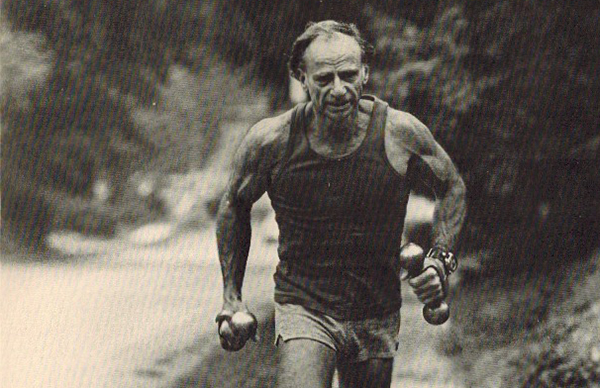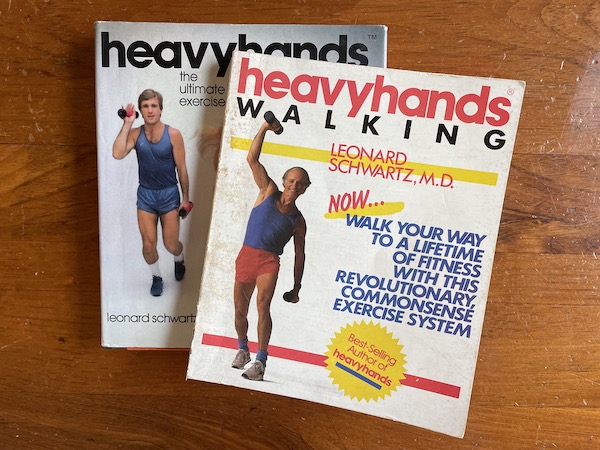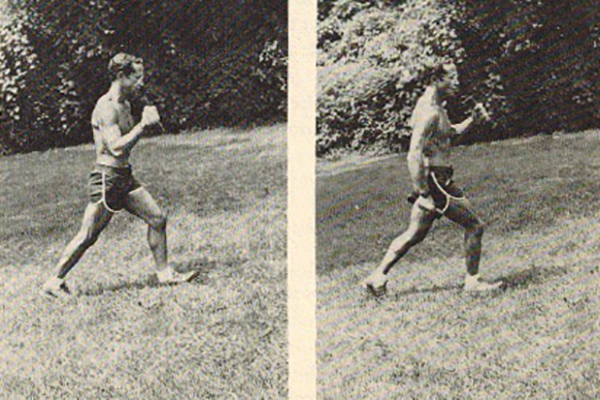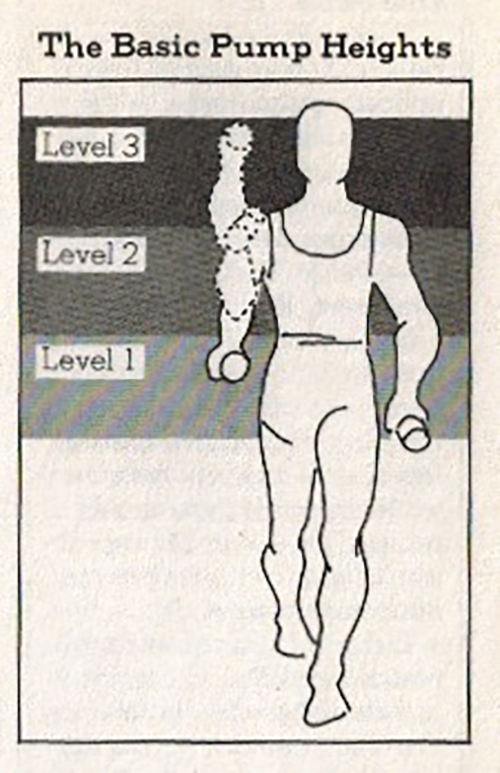
When the physician and psychiatrist Leonard Schwartz surveyed his life at middle-age, he was not particularly happy with the state of himself as a physical specimen. Decades of smoking, overwork, and living a sedentary lifestyle had left him with high blood pressure, chronic back pain, and a generally subpar level of energy.
Dr. Schwartz began incorporating swimming and running into his routine, and found these exercises brought him to a decent level of fitness. But he still felt he wasn’t where he wanted to be health-wise.
It was at this point that the good doc developed a fitness system that ultimately lowered his heart rate, cut his running times in half (despite doing less mileage), upped his strength, dropped his weight, and exponentially boosted his vim and vigor.
The name of his system was “Heavyhands” and with the publication of Heavyhands: The Ultimate Exercise and Heavyhands Walking in the 1980s, Schwartz’s methodology became something of a national sensation. Though the workout has now largely been forgotten, it’s deserving of a resurrection.
The Origins of Heavyhands Walking

The idea for Heavyhands grew out of Schwartz’s discovery that the athletes with the highest VO2 max (generally considered the best indicator of cardiovascular fitness) were not cyclists, nor runners, but cross-country skiers.
From this insight, Schwartz drew a conclusion that was both intuitive and seemingly neglected: when it came to achieving cardiovascular fitness, “Four limbs are better than two.”
Most forms of cardio, the doctor observed, greatly emphasized the lower body over the upper. Activating the latter as much as the former, Schwartz hypothesized, could thus significantly increase the workload, and the subsequent health benefits, of exercise.
Schwartz began to test his theory both on himself and in a laboratory by taking small dumbbells in each hand and then performing all sorts of exercises: striding and swinging the dumbbells using the “double pole” maneuver cross-country skiers employ; running (for distance and in place); lunging, jumping, and dancing; and just generally moving his legs and swinging dumbbell-laden arms in all kinds of directions and combinations.
While all these varied calisthenics proved effective, Schwartz found that doing the “Heavyhands Walk” — essentially walking while pumping dumbbells with one’s arms — was the “best way to begin combined, four-limbed movements” and the most natural form of heavy-handed exercise.
The Benefits of Heavyhands Walking
Walking is an oft-recommended exercise, and while it’s certainly better than doing nothing, it’s a pretty light form of activity, with lightweight benefits to match. A Heavyhands Walk transforms a pedestrian saunter into what Dr. Schwartz believed is “an exercise that makes one more mechanically strong and aerobically powerful than any other combination of exercises could.” Schwartz called it “Walk Plus” — an activity that couples all the normal benefits of walking (gets you outside, doesn’t involve real skill, can be done anywhere) with these additional advantages as well:
Whole body exercise. Even in our day-to-day life, outside of a dedicated workout, our legs get “exercise” by default by having to carry us from one place to another. Our arms, in contrast, typically just kind of hang there. Even when we do engage in intentional cardio, our lower bodies often do a greatly disproportionate amount of the work; the arms and torso are fairly inert in cycling, for example, and even when running, one’s arms swing through the air without resistance. That leaves a lot of the body on the passive table; as Schwartz observed, “While arms are small compared to legs, the upper body contains fully 65 percent of our total muscle mass!” Heavyhands engages all the muscle groups of the body, bottom to top.
Strength + cardio. While Heavyhands is primarily a cardiovascular exercise, it does build a bit of strength too. While doing thousands of repetitions with light weights isn’t going to make you big and strong, it does engage the muscles more than some other types of cardio, and athletes who have tried it have found surprising carryover improvements in their performance in their primary sports.
The same kind of benefit from doing loaded carries can of course be found in something like rucking. But not only actively carrying but manipulating the weight engages different muscles, and makes one’s walk more inefficient and effortful; carrying weight with the hands may produce up to twice the workload of carrying it supported on the back.
Convenient. By engaging the whole body, Heavyhands gives you a better workout, in less time. Plus, you hardly need any equipment and can do it anywhere, even packing your little dumbbells on a trip.
Improves cardiovascular health. Schwartz’s testing found that by adding the pumping of weights, and engaging all four limbs simultaneously, the workload, and thus the cardiovascular benefits, were greatly improved compared to conventional walking. For example, vigorously pumping 3-lb weights while walking briskly generated 2.5-3X the workload of walking without the weights, and at certain levels, Heavyhands Walking approaches the cardiovascular workload of jogging.
Effective, but low impact. Even though the cardiovascular workload from a Heavyhands walk does approach that of jogging, it’s a form of exercise that is much gentler on the body. With most forms of cardio, if you want to up your workload, your only option is to move your legs faster and harder, and that can lead to injuries. With Heavyhands, you can increase the intensity in both arms and legs, distributing the effort. And unlike with running, both legs never leave the ground at the same time, minimizing the impact of the movement. For these reasons, it can be a great cardio workout for those who are recovering from certain injuries that prevent them from engaging in their usual modality, or for those who are older and simply feeling the wear and tear of time.
Go longer, more comfortably. Relying on the intensity of your legs to power your workout can be uncomfortable and lead to the premature cessation of one’s workout. Schwartz found that by incorporating all four limbs, exercise felt easier and more comfortable, allowing people to keep at it longer.
Fat loss and improved body composition. Having observed that people hated to be deprived and almost never stuck with modifications to their eating, Dr. Schwartz did not believe in dieting for weight loss. Instead, for the exact reasons we recently outlined here, he advocated for the “Overall legitimacy of exercise as the supreme weight-controlling device.” Confident that you could shed pounds simply by adding the exercise habit alone, he thought Heavyhands — and the way it engaged the whole body and allowed for longer periods of steady-state cardio — was the most effective workout for achieving this aim.
By doing Heavyhands, Schwartz himself lost 15 pounds while eating more, and more of his favorite foods. He also found that Heavyhanders not only lost weight in general, but saw their lean muscle mass go up and their fat go down, improving their overall body composition. Strength coach Dan John, who first introduced us to Heavyhands and does the Heavyhands Walk himself, has seen this very effect born out in both himself and the clients he trains. Indeed, John says that Heavyhands is “still the best fat-burning workout for the masses.”
All in all, Schwartz considered Heavyhands Walking the optimum workout for everyone — whether young or old, currently sedentary or long-active — and thought it could be used as a person’s primary form of exercise, or as a supplement to their other athletic pursuits.
How to Do Heavyhands Walking
Back in the 1980s, people heard about Heavyhands through the grapevine, maybe flipped through Schwartz’s books, and figured the concept was simple enough that they needn’t bother to actually read them.
As a result, many thought they knew how to do a Heavyhands Walk and went for it. Then, when they didn’t get the results they sought, they abandoned the idea, blaming the methodology.
Heavyhands is pretty simple, but there are things you have to understand and adopt if you want to see real results. Let’s talk about what those things are:
The Pump. This is key to the effectiveness of Heavyhands Walking, and the most common thing people neglect (and then wonder why the method isn’t working for them). You don’t simply carry dumbbells in your hands when you do a Heavyhands Walk; you pump them.
While carrying weights in any fashion will increase the workload of a conventional walk, pumping them versus letting them dangle by your side will recruit more muscle and increase the required effort, and the attendant benefits. For example, Schwartz’s lab found that you would burn 4X more calories high pumping 2-lb weights than carrying 15-lb weights at a dead hang.

The “pump ‘n’ walk.”
To do the proper “pump ‘n’ walk,” take a “diagonal stride,” swinging the arm opposite the striding leg, i.e., when your left leg is striding forward, your right arm is pumping, and vice versa. Keep your elbows close to your sides, and curl the weight up, palms facing inward.

The three levels at which to pump your dumbbell-holding arms.
There are three standard levels to the pump and each level represents one foot: “Measuring with the hands hanging straight down at your sides, if you’re about average height, Level 1 hits you about belly button high, Level 2 near the front of the shoulder joint, Level 3 about the top of your head.” You can also shoot for the moon and go for Level 4, pumping “about as high as most of us can pump without losing the limb!” The higher you pump, the harder the work. The different pump levels also emphasize different muscles, with levels 1 and 2 targeting the arms, and 3 and 4 recruiting your shoulders, upper back, and chest.
With every pump, don’t just emphasize the upwards arc, but also intentionally pull the weight down on the downstroke rather than just letting it fall; a deliberate pull on the eccentric side of the movement will engage your lats, triceps, and pectorals.
The Weights. To perform a Heavyhands Walk, you walk while holding a dumbbell in each hand. Schwartz describes the Heavyhands Walk as a form of “strength-endurance,” but the emphasis is definitely on the endurance part of things. You want to carry weights heavy enough to offer a little resistance, engage the muscles, and add to the workload, but light enough that you can pump your arms with them for an extended period of time.
If you’ve already been lifting weights, you’ll probably greatly overestimate how much you can heft. As you’ll quickly find, pumping a weight a thousand times is a whole different ball game from doing a set of ten.
So start with two-pounders (or even one-pounders), and go from there. If you really do this regularly, you may end up increasing the weight of each dumbbell to something like 10 lbs, but sub 5-pounders are going to be right for nearly everyone at the start, and for a long time after.
Any hand weights will do, but Schwartz recommends getting ones with a strap that goes around the back of the hand to support the weight and reduce the need to overgrip it; with or without the hand strap, you don’t want to grip your dumbbells too tightly, as this will lead to fatigue and spasm.
The Regimen. Schwartz recommended doing three to four 30-minute Heavyhand sessions a week. But you can find a length and frequency that works for you.
A good, moderate place to start (you may need to scale back if you’re totally new to exercise) is walking with 2-lb weights, doing the Level 2 pump, for 30 minutes. You may need to intermittently revert to Level 1 at times to rest your arms before returning to Level 2.
To increase or decrease the intensity of your walks, you can play with three variables: pace, weights, and pump level. To up the intensity, walk faster, carry heavier weights, and/or pump higher; to lower the intensity, do the converse.
If you wish to throw in a greater emphasis on the strength side of things, Schwartz recommends using the heaviest weights you can pump for 10% of the time you Heavyhands Walk. You’ll have to slow your pace, and/or lower the pump height to make this doable. Keep in mind that upping the weights will make the workout more anaerobic and less aerobic.
While Dr. Schwartz believed the Heavyhands Walk alone was plenty sufficient to keep your fitness tuned up, he felt that, ideally, you’d also incorporate other moves into your walk as well in order to target different muscles. This included all manner of goofy-looking kicks, struts, skips, leg lifts, punches, lunges, and duckwalks, which, realistically, the average person is not going to feel comfortable performing. At least in public.
Schwartz himself admitted that there was a potential embarrassment factor to be overcome even with doing the standard Heavyhands Walk itself. Though, he thought it wouldn’t be a factor we’d have to contend with in the 21st century, as he was confident that Heavyhands wasn’t a fad but would instead become a permanent, commonplace fixture of the fitness landscape. “The nice thing about social embarrassment phenomena is that . . . they disappear as fast as they emerge,” Schwartz predicted back in 1987. “When people discover that the odd movements associated with pump ‘n’ walk produce exhibitable muscular rips and cuts, the embarrassment will vanish. You can count on it.”
Well, the good doc was wrong about that. But, he was right about the effectiveness of the workout he birthed. So just try to walk where people won’t see you. Or briefly stop pumping when a car drives by. Or, best of all, put on some sweatbands, embrace your inner, totally tubular 1980s walking dad, and stop caring what people think about you already.
The post The 1980s Walking Workout That Will Actually Get You in Shape appeared first on The Art of Manliness.
0 Commentaires